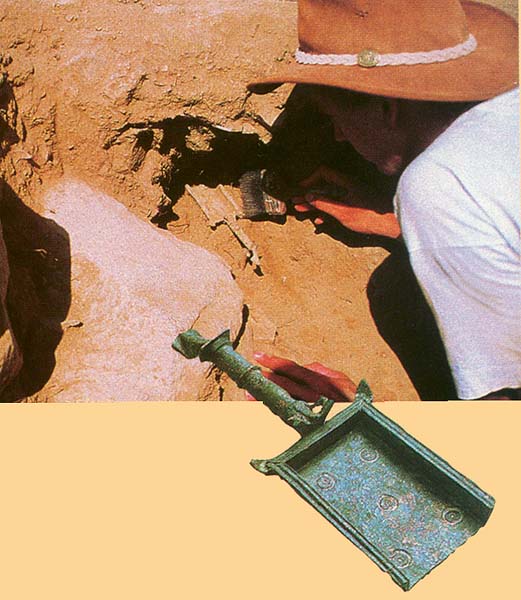Bethsaida 8-inch-long bronze incense shovel, discovered in 1996.
The shovel lay in a first-century C.E. refuse pit. Just a few meters away is the corner of a building. In part because of the shovel, we have tentatively identified the building as a Roman temple. Situated on top of the mound, the building is oriented in an east-west direction and has a ground plan typical of Roman temples—a porch with at least one column at the center, a pronaos (approaching hall), a naos (the holy of holies) and an opisthodomus (back room). Among the debris were decorated stones and figurines, which also lend support to our identification of the building as a temple.
X-rays reveal that the shovel was cast in one piece, probably using the the lost-wax (cire perdue) technique, in which molten metal is cast in a mold formed with the use of wax.
The shovel has a handle shaped like a Corinthian capital and a rectangular pan decorated with two small leaves, resembling a horned altar. The pan itself is also engraved with five concentric-circle designs, perhaps not just for decoration.
In 30 C.E. Philip, the son of Herod the Great, elevated Bethsaida to the status of a Greek polis (city) and renamed it Julias in honor of Julia, known better as Livia, the wife of the emperor Augustus. Julia died in 29 C.E. Bethsaida’s status as polis, together with the temple and incense shovel, suggest that this site was one of the centers of the Roman imperial cult.
Philip’s father had earlier built three magnificent temples in other parts of the country and renamed the cities in the same fashion.
Bethsaida is mentioned in the Gospels more often than any city except Capernaum and Jerusalem. Thus Jesus may have developed and expounded his theology in the shadow of an important center for the Roman imperial cult in Palestine.
Rami Arav and Richard A. Freund, “Prize Find,” BAR Jan-Feb 1997.
See also-
